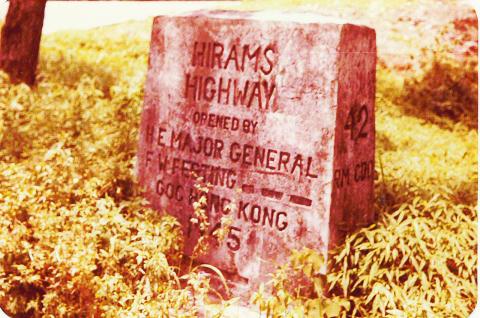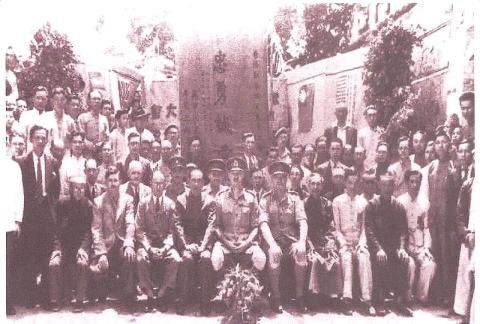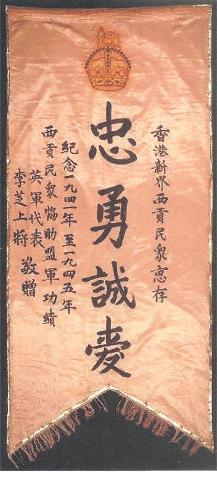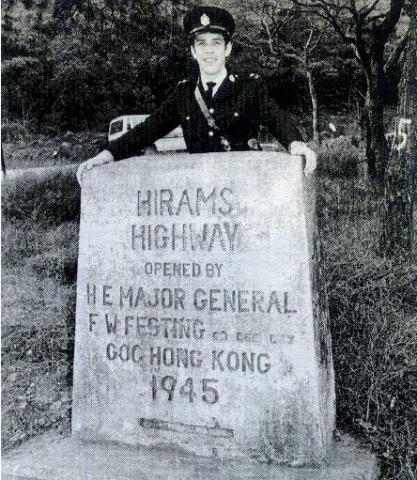Whilst researching a book on the History of Hebe Haven Yacht Club a few years ago, I thought I’d check out the history behind the naming of Hirams Highway, and in doing so discovered quite a few differing versions about the builder of the road, from Hiram Potts, to K. Potts to a Lt. Potts to a Captain Potts and even a Major Potts.
I have known of the story for many years and have even had pictures taken by the original stone that names the road (it used to be just where you turn off Clearwater Bay Road onto Hirams Highway-in actual fact it is still there but a little further down and almost hidden in the shrubbery).
I also knew that he earned the nick name ‘Hiram’ because of his love of the American brand of sausages called “Hiram K. Potts” sausages.
Note the 42 RM CDO (42 Royal Marine Commando) on the side
Courtesy 42 RM Commando
Even Sir Denis Bray in his book ‘Hong Kong Metamorphosis’ named him incorrectly as Hiram Potts, but had correctly recorded the fact that he was a Lieutenant in the Royal Marine Commando’s. This is how he described his time as a District Officer.
“The district had no major towns and only two roads. One was a good two lane pre-war road down the length of the Clear Water Bay peninsula to a gun emplacement for the defence of the eastern approaches to Hong Kong. In early postwar years, a permit was required for access to this road as nearly the whole length of it was used as an ammunition stores, the munitions being stored in little huts at intervals on alternate sides of the road. The main road to Sai Kung town was a jeep track rejoicing in the name of Hiram’s Highway. It was built by the army in the very early postwar years as a reward for the resistance by the Sai Kung people during the Japanese occupation.
General Ritchie presenting the banner and monetary rewards
as thanks to the people of Sai Kung in 1947
Courtesy HKMCD
The road derives its name from the Commando Lieutenant, Hiram Potts, who was in charge of its building in the early postwar days. He and his commandos laboured alongside people of the district to construct a perilous jeep track down from the Clear Water Bay Road. Traffic could only move one way, and if you missed the timing, you had to wait forty minutes for the next window of opportunity. The widened road was only opened for two-way traffic just before Chinese New Year in 1960."
Lieutenant John Wynne Potts of 42 Royal Commando had had a good war raiding the Japanese in coastal Burma. He arrived in HK with Admiral Harcourt's liberation fleet. During the war a lot of American food was shipped or dropped to British troops as part of the Lend-Lease Agreement, and amongst the food supplied to the Commandos was Hiram K Potts tinned sausages, and he loved them. The English love a nickname so Lt. John Wynne Potts acquired the nickname of Hiram.
Sai Kung prior to the war, had always been remote and difficult to get to, one of the reasons the Japanese found it difficult to control, the other being that the area was also the home of the Hong Kong Independent Battalion of the Guangdong Peoples Anti Japanese Guerrilla Force. (a branch of the East River Column)
The only way in was by a footpath or a boat. So with military logic, a Marine Commando, with an engineering background limited to digging trenches in India and gun emplacements on the Orkney Islands in Scotland, now had the task of constructing a road, to live up to the Marine motto ‘per mare per terram’ by land and sea. With his company of eighty Marines as well as Japanese and Korean POWs he set to building the road. A visiting officer seeing him at work made a sign saying Hiram's Highway and the name stuck. This was replaced later with a concrete block ‘cementing’ its name as Hirams Highway.
Wynne-Potts stayed in the Marines for 36 years retiring in 1978, also seeing action in Cyprus and Malaya. His son later became an inspector in the HK Police and posed by the stone.
Inspector Chris Wynne-Potts RHKP
Courtesy Colin Aitchison
By this time (1949) Potts had transferred from 42 Commando to 40 Commando and was still in HK. At a full dress parade, upon receiving the order 'Officers draw swords' Potts drew and presented his, but it was broken in half, he had been in a light hearted (drunken) sword fight with a fellow officer the night before and his sword had an accident. He completed the whole parade with only half a sword.
As one can see from his military records, he stayed in the Royal Marines for some time, retiring finally in 1978. He was only promoted to Honorary Major on his retirement. He died in 2009 in Chichester




Chris Wynne-Potts
Interesting stuff. I knew Pottsy (as Chris was universally known in the RHKP) in the late 1970's when we served together. He only did the 1 tour of 3 years duration in the Force, & I recall how long & hard he thought about joining the Royal Marines before he left HK. In the end he decided against it & moved to South Africa, where I think he still lives. My goodness me, was Pottsy ever a good rugby player! One of the best in the Colony - great flanker. Hard as nails.
He once told me a great story about his dad at a ball or function in the Peninsula Hotel when the Brits came back in 1945. Apparently Royal Marines were present, in uniform, as were US Marine Corps personnel. Pottsy's dad went up to some US Marines and, pointing to the "RM" on his epaulette, said to an American; "you see that? It stands for REAL Marine!" The scrap which ensued had to be seen to be believed, apparently!
Chris Wynne-Potts
Please see the following email from Chris about his father. You have a very good memory of the Penninsula incident.
Dear Bill,
Thanks for the article and I enjoyed reading it. The old man actually joined the RM during the war and started life off as private before getting a War time commission and after various bits of training had to manage a pioneer battalion ( almost entirely made up of convicts) at Scapa Flow in the Orkney islands for a few months. I remember a story he used to relate where he had to defend a prisoner who was caught having carnal relations with a sheep ---- the old man had absolutely no idea what defense he could give as the unlucky chap had been caught red handed and in desperation he said to the presiding judge “ your honour my client in his defense was at the time so drunk that he thought it was a wren with a duffle coat on”. As a young lieutenant he was sent to Burma and was shot by a Japanese sniper in a tree and his batman then shot the jap who was in the tree. His name was Basher Barks and they remained friends for life. His actual name was John Wynne-Potts and as you mentioned got his nick name Hiram through tinned sausages that were part of their rations in Burma. The sausages were made by someone called Hiram K Potts of Milwaukee USA and the old man loved them and everyone else hated them and he used to swop some of his rations with others for their sausages and the nick name stuck as they shared the same surname.
He used as you mention Korean and Japanese POW’s to build the road and it came about partly as he was told to put the prisoners to some use and also because there was a need to build / upgrade the road / track from Clearwater Bay down to Sai Kung, he had no idea about building roads and it was very much about “ trial and error” He did say that they had lots of dynamite but very little fuse wire and the prisoners had to draw straws to determine which one had to run down the hill light the fuse wire and try and run to safety before the dynamite went off and apparently many didn’t get away in time either because the fuse was too short or they had over calculated on the amount of dynamite they needed---- as the old man use to say he wasn’t much good at how a slide rule worked.!! I don’t know whether it used British army personnel but the old man was a Marine and not in the army.
Reference the Peninsula Hotel it must have been around 1946 I think and they had a big function at the hotel which would have been very different looking hotel than it is today. Apparently a big fight started when the US Marines and the British marines didn’t see eye to eye about something. According to the old man on of the triggers was when one of the British Marines went up to one of the US Marines and pointed to the RM insignia on his lapel and said what does this mean, when the US marine was unable to give a reply the answer came back as “ REAL MARINE” and then all hell broke loose.
There were two opposite staircases going up from the lobby in a winding semi-circle, the party was taking place on the ground floor lobby, old man had seen Errol Flynn in a film swing down from the chandeliers into the melee below and carry on the fight. He thought he would do the same and although he managed to grab the chandelier it came out of the ceiling and crashed down below amongst the various participants of the fight, everyone was covered in glass and dust.
He said that while many were caught by the Military Police he and others managed to escape through the kitchens – he loved his time in HK and I am sure being just after the war it was the wild west and must have been a great adventure where anything goes !!
He also helped start up “Jimmy’s Kitchen” after the war where the owner of Jimmy’s kitchen needed to get his restaurant running again and asked the old man if he could supply any bulk food rations and in return he would cook for the soldiers either at a discount of free and as a result the old man supplied cases and cases of bully beef and helped to get Jimmy established again.
The old man besides HK also was in Malaya and Cyprus during the troubles and met my Mum in the early 50’s and married her in 1956 I think but unfortunately she died as a result of child birth when I was 10 days old. She was also at one time a wren and snow skied for England. Anyway the old man spent many years in the Marines and retired in 1978 as a Major and certainly had a colourful career.
Kind Regards Chris
Great stories!
Thanks to Bill and Chris for posting them,
Regards, David
Hirams Highway
The original road to Sai Kung appears to have been built by the Japanese, but not maintained.
WO 208/750A Intelligence Reports. Oct 45 - Aug 46.
Undated entry: The road built by the Japanese branches from Clearwater Bay Road northwest of Taipo Tsai, and the first mile is merely a cutting in the hillside, liable to be washed away in wet weather. However, as far as Sai Kung itself, the road is jeepable, and with the dry season approaching, small repairs carried out on the surface of the road could quickly make it suitable for medium transport traffic.
Hiram's Highway - Double Lane
China Mail 10 February 1961
The section of Hiram's Highway between the village of Ho Chung and the fishing centre at Sai Kung will be opened to two-way motor traffic on 11 February. The timing restrictions in force for single-way traffic for that section of the road will no longer apply.
Capt. John Wynne Potts / HK's Liberation
Long story short - 12 years ago when I was visiting my sister, Lindy, & brother-in-law, Lindy was showing me around the house and we ended up in the attic. I saw her stack of photo albums and the 8mm films my father gave her. I asked her if she was going to transfer the films into DVDs and she said NO! She was going to throw the films and the albums into the rubbish bin
I offered to take her albums and scan them for her but she said a firm NO, so that was that.
Fast forward to 2020. My sister isn't very well with a type of aphasia which has morphed into something like Alzheimer's so I told Willem (my B-i-L) what Lindy said 12 years ago and asked if Willem would be a sweetheart and send me those old photos up to the time they got married in 1963, and he said that he'd consider it!
A couple of months later, Willem emailed me to say that he had sent me a box with 7 KILOS of photos - this from France to Oz by airmail - so you can imagine how much it cost him!! I was thrilled beyond measure!!
I was thrilled beyond measure!!
I scanned the ones of her first two albums, which my father did for her, and a few weeks ago, I posted a couple of them on the Battle for HK's Facebook page. The date is a bit iffy as on the front, my father wrote "Feb 1946" but on the back he wrote "Nov 1945"!
I was amazed to get a message from Bill Lake saying ...
Here's the photograph (drum roll ....!!)
As you can see, I opted for the Nov 1945 date
I would be so happy if anyone here could tell me more about what this photo was all about, as would Bill Lake, I'm sure! Originally I thought Lindy (front right) was holding onto a gun of sorts but Bill Lake said it looked more like she was holding bagpipes Duh me!!!
Duh me!!!
Capt Wynn-Potts
Anyone who wants to know more about the Captain, or the photo, or the building of Hiram's Highway, could do a lot worse than write to his son Chris, who lives in South Africa.
Pottsy, (we always called him that, never Chris), and I worked together in the RHKP in the mid-late 1970's. He was a real character and told me some stories about his dad.
I can supply an e-mail address.
Capt John Wynn-Potts / HK Liberation
Thanks so much for that information! Bill Lake had already emailed Pottsy, who confirmed it was his father in the photo, but he couldn't shed any light as to the occasion.
Cheers
44 Commando
My father was in Hong Kong as a Lieutenant with 44 Commando Brigade in 1946, he is 4th from left in front row with his platoon somewhere in the NT.
He transferred to 40 Commando in 1947.
Who Built Hirams Highway - segue to British Army Mules
I knew a restaurant owner in Caernarfon, North Wales, called Kong Siu Wing (Tony Kong) who had grown up in Lung Mei Tsuen (龍尾村), a small Hakka village located just north/northwest of Sai Kung. He said that during the Japanese Occupation, as a teenager, he'd been in a forced labour group building the road out of town that later became Hiram's Highway. He said the workers only received a small amount of rice each day.
He later served in the British Army, saying he was at one time based at Lei Yue Mun (Lye Mun) Barracks, and had served as a 'mule driver'. I assumed this was a 'mechanical mule', but an online search showed there were equine mules of the 414 Pack Transport Troop through to 1976 at Lo Wu Camp. The Gurkha Transport Regiment was based at Lye Mun from 1976, but I don't know if they had mules. (Details found by searching http://british-army-units1945on.co.uk/royal-corps-of-transport/)
Some interesting film clips of British Army Mules in Hong Kong:
Much later, Mr Kong paid (or helped pay) for the Lung Mei Village Road from the junction with Shan Liu Sheung Road.